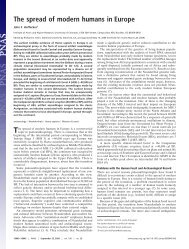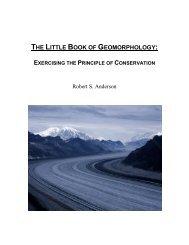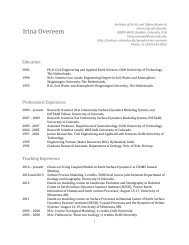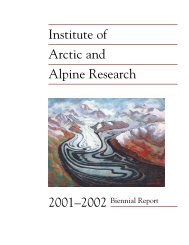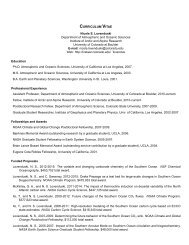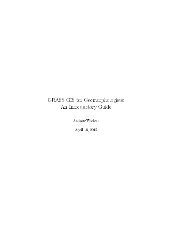Glacier Mass Balance and Regime: Data of Measurements and ...
Glacier Mass Balance and Regime: Data of Measurements and ...
Glacier Mass Balance and Regime: Data of Measurements and ...
Create successful ePaper yourself
Turn your PDF publications into a flip-book with our unique Google optimized e-Paper software.
November in the south), <strong>and</strong> summer (1 June – 30 September in the north, 1 December – 30 April 30 inthe south).The glaciological method (so-called “stakes <strong>and</strong> pits” method) is based on the method developedin hydrology, particularly in snow-hydrology, to measure snow-water balance in a basin. The methodwas applied, possibly the first time, to study the regime <strong>of</strong> Rhone <strong>Glacier</strong> at the end <strong>of</strong> 19th century(Mercanton, 1916). In the 20th century, the method was developed in more detail <strong>and</strong> applied to studythe regime <strong>of</strong> several glaciers around the Atlantic coast in Northern Europe (Thorarinsson, 1940;Ahlmann, 1948). Continuous <strong>and</strong> uninterrupted measurements started in 1945 on Storglaciären, inKebnekaise, Sweden Lapl<strong>and</strong> (Schytt, 1962; Holmlund et al., 1996) <strong>and</strong> spread in consequent years byresearchers working in mountain areas in Europe, North America, the Arctic <strong>and</strong> Asia.Reports <strong>of</strong> direct measurement by the “stakes <strong>and</strong> pits” method have <strong>of</strong>ten implied that theydetermine the change in mass <strong>of</strong> ice in a column from the surface to the bottom <strong>of</strong> glacier; in reality,these measurements usually pertain only the uppermost recent annual layer. The basic equation <strong>of</strong> thisglaciological method for a point is,db/dt = ρdh/dt + œGρ/dt dz , (1)where ρ is the density <strong>of</strong> the ice layer <strong>of</strong> thickness h, changing over period <strong>of</strong> time t (Hubley, 1954).Thefirst term on the right side is the change in ice mass over a period <strong>of</strong> time with constant density <strong>and</strong> thesecond member is the change in density over period <strong>of</strong> time over a column <strong>of</strong> thickness z.For practical application equation (1) can be rewritten as:b i = ρ 0 ∆h+ (ρ 2 h 2 – ρ 1 h 1 ). (2)Here b iis the mass balance at a site, ρ 0 is the density <strong>of</strong> ice (usually considered to be 0.90 g cm -3 , butmay vary from 0.82 to 0.92 (Shumskiy, 1959), <strong>and</strong> ∆h is the change, relative to the top <strong>of</strong> a stake, <strong>of</strong> thesurface level <strong>of</strong> ice. The first term in the right side <strong>of</strong> equation (2) can usually be applied to determinethe ablation <strong>and</strong> balance <strong>of</strong> solid ice. The second right h<strong>and</strong> term <strong>of</strong> (2) is applied for porous material(snow <strong>and</strong> firn) with changing density over time (e.g., between two consecutive surveys). Thus, equation(2) can be used to calculate mass balance at any point (site) on a glacier where measurements are carriedout. The general recommendation is to carry out measurements at sites on a glacier twice a year todetermine annual (or net) mass balance (∅strem <strong>and</strong> Brugman, 1991). The first survey is usually takenat the beginning <strong>of</strong> a mass balance year (or the end <strong>of</strong> the previous year) in order to mark the summersurface.28



